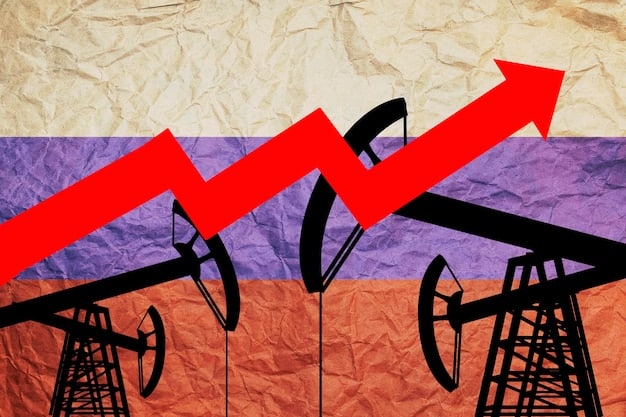Middle East Crisis Impact: US Oil Price Forecast & Analysis

Analyzing the Impact of the Current Middle East Crisis on US Oil Prices: A Financial Forecast reveals potential price volatility due to geopolitical instability, supply disruptions, and altered market dynamics arising from tensions in the Middle East.
Geopolitical tensions in the Middle East have always been a critical factor in global oil markets. The current crisis is no different, and its effects are already being felt in the United States. Analyzing the Impact of the Current Middle East Crisis on US Oil Prices: A Financial Forecast requires a deep dive into the complexities of oil production, supply chains, and international relations.
Understanding the Middle East’s Role in Global Oil Supply
The Middle East is a cornerstone of global oil production, housing some of the world’s largest oil reserves and playing a crucial role in meeting global energy demands. Instability in this region can have severe repercussions for oil supply, leading to price fluctuations worldwide.
Key Oil Producers in the Middle East
Several countries in the Middle East are vital to the global oil supply. Disruptions in these nations can significantly impact the market.
- Saudi Arabia: The world’s largest oil exporter, capable of influencing prices through its production levels.
- Iran: Despite sanctions, Iran remains a significant oil producer, and its geopolitical actions can affect market sentiment.
- Iraq: Recovering from years of conflict, Iraq’s oil production is still vulnerable to instability.
Potential Supply Disruptions
Conflicts or political instability can disrupt oil production and transportation, leading to shortages and price increases.
The closure of key shipping lanes, such as the Strait of Hormuz, could severely restrict oil flow from the Middle East, impacting global supply. Escalating conflicts could directly damage oil infrastructure, hindering production and export capabilities. Geopolitical tensions can lead to sanctions or trade restrictions, further limiting the availability of oil from the region.

In summary, the Middle East’s crucial role in global oil supply means any disruption in the region can quickly translate into price volatility and supply concerns worldwide.
Geopolitical Factors Influencing Oil Prices
Geopolitical events in the Middle East are a primary driver of oil price volatility. Conflicts, political instability, and diplomatic tensions all contribute to uncertainty in the oil market.
How Conflicts Impact Oil Markets
Armed conflicts can directly disrupt oil production and infrastructure, leading to decreased supply and increased prices.
- Infrastructure Damage: Attacks on oil facilities can halt production and export capabilities.
- Increased Uncertainty: Conflicts create uncertainty among traders and investors, driving speculative buying.
- Geopolitical Risks: Heightened tensions can lead to further disruptions and supply shortages.
The Role of Political Instability
Political upheaval and government changes can lead to inconsistent policies and disruptions in oil production.
Political instability can create an environment of uncertainty, making it difficult for oil companies to invest and operate. Changes in government can lead to shifts in oil policies, affecting production quotas and export agreements. Geopolitical risks prompt responses from major oil-consuming nations, such as the US and China, influencing global demand.
In conclusion, geopolitical factors, particularly conflicts and political instability, exert significant influence on oil prices by disrupting supply, increasing uncertainty, and altering market dynamics.
US Dependence on Middle Eastern Oil
The United States, while increasing its domestic oil production, still relies on imports from the Middle East to meet its energy needs. Understanding this dependence is crucial to assessing the impact of Middle East crises on US oil prices.
Current Import Levels
Despite increased domestic production, the US continues to import a significant amount of oil from Middle Eastern countries.
While the US has reduced its overall dependence on Middle Eastern oil in recent years, imports from the region still play a vital role in meeting domestic demand. Shifts in global supply dynamics, such as disruptions in other oil-producing regions, can increase the US reliance on Middle Eastern oil. Strategic Petroleum Reserve acts as a buffer, but prolonged disruptions can still impact consumer prices.
Strategic Implications
Reliance on Middle Eastern oil has strategic implications for US foreign policy and economic security.
- Foreign Policy: The US must maintain diplomatic relations with Middle Eastern countries to ensure a stable oil supply.
- Economic Security: Dependence on foreign oil makes the US vulnerable to price shocks and supply disruptions.
- Geopolitical Leverage: Oil-producing nations can exert influence over US foreign policy decisions.
In sum, while US dependence on Middle Eastern oil has decreased, it remains a significant factor in the nation’s energy security and foreign policy considerations.
Financial Forecasting: Predicting Oil Price Movements
Predicting oil price movements in the face of Middle East crises requires a comprehensive analysis of market factors, geopolitical events, and financial indicators. Investors and policymakers alike use forecasting models to anticipate potential price fluctuations.
Factors Influencing Price Forecasts
Several factors can influence oil price forecasts, including geopolitical events, economic indicators, and market sentiment.
Geopolitical Events directly impact supply expectations, Economic Indicators (such as GDP growth and inflation) affect demand forecasts, and Market Sentiment, driven by news and speculation, can amplify price swings. Seasonal demand changes, such as increased travel during the summer, also play a role. Technological advancements, like improved extraction methods, can influence long-term supply projections.
Forecasting Models
Various forecasting models are used to predict oil prices, ranging from simple trend analysis to complex econometric models.
- Technical Analysis: Using historical price data to identify patterns and predict future movements.
- Fundamental Analysis: Assessing supply and demand factors, geopolitical risks, and economic indicators.
- Econometric Models: Using statistical methods to analyze the relationship between various economic variables and oil prices.

In closing, accurately forecasting oil prices requires a combination of technical, fundamental, and econometric analysis, taking into account a wide range of factors that can influence market dynamics.
Impact on US Economy and Consumers
Fluctuations in oil prices have a direct impact on the US economy and consumers, affecting everything from gasoline prices to inflation rates. Understanding these effects is crucial for policymakers and households alike.
Gasoline Prices and Consumer Spending
Rising oil prices directly translate into higher gasoline prices, reducing consumer spending on other goods and services.
Increased gasoline prices can significantly impact household budgets, leaving less disposable income for discretionary spending. Businesses also face higher transportation costs, which can be passed on to consumers through increased prices. Changes in consumer behavior, such as reduced travel or increased use of public transportation, can further affect economic activity.
Inflation and Economic Growth
Oil prices play a significant role in overall inflation rates, influencing the cost of goods and services across the economy.
- Inflationary Pressures: Higher oil prices can lead to increased costs for transportation, manufacturing, and energy, contributing to overall inflation.
- Economic Slowdown: High oil prices can reduce consumer spending and business investment, leading to slower economic growth.
- Monetary Policy: The Federal Reserve may respond to rising inflation by raising interest rates, further impacting economic activity.
To summarize, oil price fluctuations impact the US economy and consumers by directly affecting gasoline prices, influencing inflation rates, and potentially slowing economic growth.
Mitigation Strategies and Policy Responses
In response to the potential impact of Middle East crises on oil prices, the US government and private sector employ various mitigation strategies and policy responses. These measures aim to stabilize the market, protect consumers, and enhance energy security.
Strategic Petroleum Reserve (SPR)
The SPR is a critical tool for managing oil supply disruptions, providing a buffer against price shocks and shortages.
The Strategic Petroleum Reserve (SPR) holds hundreds of millions of barrels of crude oil. In times of crisis, the President can authorize the release of oil from the SPR to increase supply and stabilize prices. This action can calm market fears and prevent significant price spikes.
International Cooperation
Cooperation with other oil-consuming and producing nations is essential for maintaining a stable global oil market.
- Diplomatic Efforts: Engaging with Middle Eastern countries to promote stability and prevent conflicts.
- Coordination: Working with international organizations such as the International Energy Agency (IEA) to coordinate supply responses.
- Agreements: Establishing agreements with other countries to share oil reserves in times of crisis.
In conclusion, mitigation strategies such as the Strategic Petroleum Reserve and international cooperation are vital for managing the impact of Middle East crises on US oil prices and ensuring energy security.
| Key Point | Brief Description |
|---|---|
| 🔥 Geopolitical Impact | Crises disrupt supply, increasing prices. |
| 📈 US Economy | Gas prices rise, impacting consumers. |
| 🛡️ SPR | Used to mitigate supply disruptions. |
| 🌍 Global Relations | Cooperation ensures market stability. |
Frequently Asked Questions
▼
Middle East conflicts can disrupt oil production and supply, leading to higher prices due to increased uncertainty and potential shortages. This directly impacts US gasoline prices.
▼
The SPR is a US government stockpile of crude oil used to mitigate supply disruptions. It helps stabilize prices by releasing oil into the market when necessary during crises.
▼
Despite increased domestic production, the US imports oil to meet demand and diversify supply. Middle Eastern oil remains important for this purpose and because of global supply dynamics.
▼
Consumers can reduce their reliance on gasoline by using public transport, carpooling, or buying fuel-efficient vehicles. They can also reduce energy consumption at home to lower overall expenses.
▼
Long-term solutions include investing in renewable energy sources, improving energy efficiency, and diversifying oil supplies to reduce reliance on any single region with geopolitical instability.
Conclusion
Analyzing the Impact of the Current Middle East Crisis on US Oil Prices: A Financial Forecast reveals that tensions in the region continue to significantly influence the US oil market. Geopolitical instability, potential supply disruptions, and strategic policy responses all play a role in shaping oil prices and impacting the American economy, making vigilance and informed decision-making crucial for consumers and policymakers alike.





